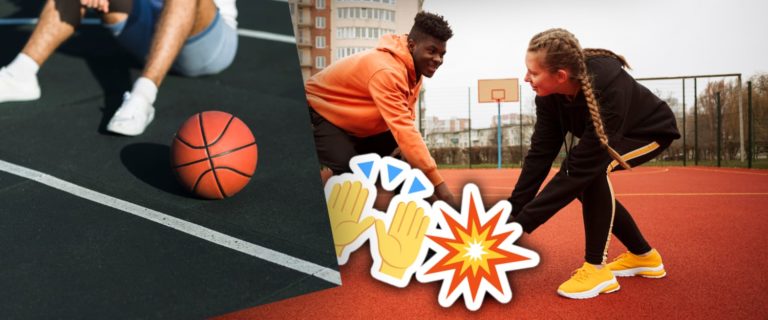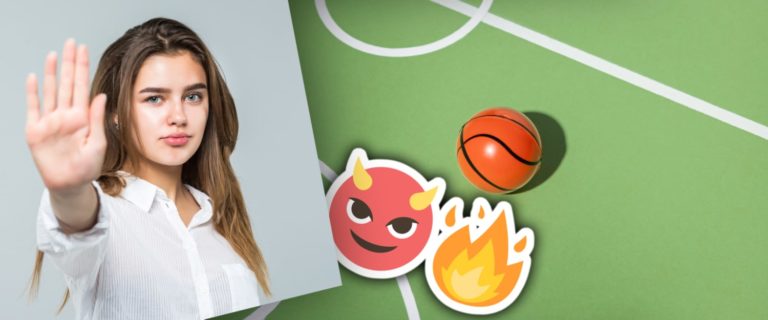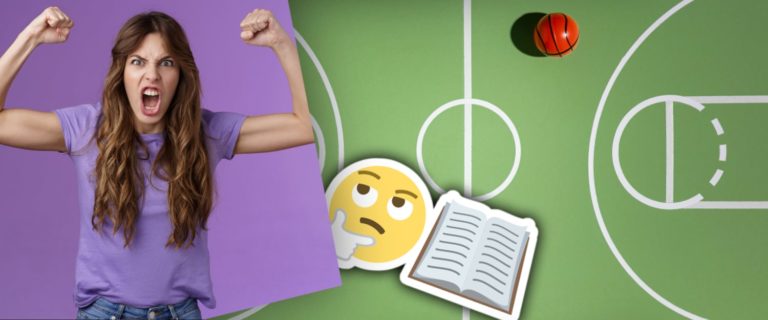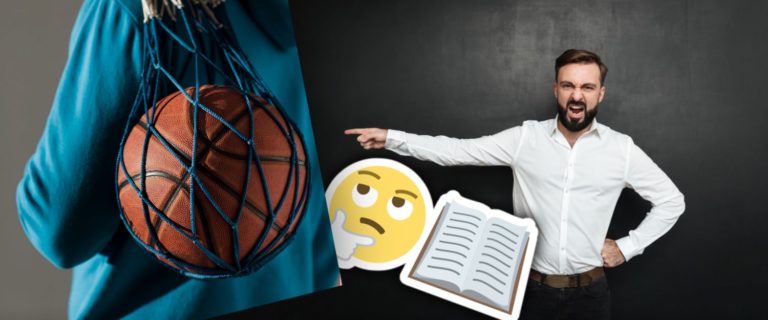How To Dribble A Basketball 101: Training Drills And Tips
Dribbling a basketball is one of the most important skills in all of basketball. It’s how you move around on the court and how you get open to take shots at the hoop. Whichever way you do it, many different types of dribbles can be used for various situations.
In this blog post, we will go over how to perform these different dribbles. As well as how to improve them through drills and exercises. Finally, we will mention how crucial it is that every player knows how to properly dribble a basketball!
Basic Dribbling, Step-by-Step

Have Control Over the Ball and Relax
- Dribble the basketball with your fingertips, not your palm.
- Keep the ball in control at all times and don’t slap or swat it away when dribbling. This leads to turnovers!
- Hold the ball firmly but relax your hands; tense muscles tire easily.
- Don’t grip the ball too tight; you need some feel for how much friction is between your hand and the ball (e.g., how hard you can squeeze before slipping).
- Spread out fingers on top of basketball instead of making a fist around it; this allows better bouncing off each finger individually for more powerful dribbles like crossovers.
Get Down Low, for Stability and Quicker Moves
When to get down low: when crossing over, between the legs, or behind back to make quick moves around defenders; while using fakes such as jab steps and pump fakes; anytime you need more stability for power/speed of your move.
Getting down low when dribbling a basketball is important for several reasons:
- Better ball control: When you get down low, you have more control over the ball. You can use your body to shield the ball from defenders and maintain possession of the ball while dribbling. Being low also allows you to use your off-hand to protect the ball and prevent turnovers.
- Improved speed and agility: Being low to the ground allows you to move faster and change direction more quickly. When you’re low, you have a lower center of gravity, which means you can shift your weight and change direction faster. This makes it harder for defenders to keep up with you and allows you to create scoring opportunities.
- Better balance: Getting down low helps you maintain better balance while dribbling. It allows you to distribute your weight evenly and stay grounded, even when defenders are trying to knock you off balance. This makes it easier to stay in control of the ball and make quick, accurate movements.
Push the Basketball into the Ground
Push the basketball into the ground and then bounce it back up; this is how you can increase the speed of your dribble.
When to push: when speeding up for a faster move such as crossovers, between-the-legs moves, or behind-the-back moves.
- Keep arms bent at around 90-degree angles. So that they are ready to shoot out forward quickly with less telegraph time (i.e., how long before uncoiling). If too high above the head, the defender will have more chance of getting in front of the shot/pass!
- Bend legs slightly while pushing down on the ball to absorb some shock from rough court surfaces found outside gymnasiums. This also makes it harder to knock off balance.
- Push fast but still in control to get the basketball up quickly; how quick this depends on how effective your move was!
- Rotate wrists while pushing down on the ball. So that it rolls underneath your fingers instead of just bouncing off them, which increases speed even further!
Practice dribbling hard/fast by pushing into a wall or plyometrics box (e.g., Sklz Accelerator Pro). This helps players with ball security for moves during games when they are tired and need more speed without losing control of their dribble.
Protect the Basketball from the Opponent
Don’t let the opponent take your basketball away if you’re using it!
- Protect the ball by keeping elbows close to the body and holding the ball out with the dominant hand. Instead of letting it dangle. This allows quick switching from one arm to another for more power when dribbling. This also keeps arms closer together. So that opponents can’t get between them as easily, which is how they might try to steal the ball.
- To keep control, don’t bounce or tip-toe too much because this takes a high level of skill; only do these things during a crossover move. Where you need some extra height off ground (e.g., Allen Iverson’s signature move). If not necessary, don’t risk losing possession! Passes are always better than turnovers!
- Don’t let the defender push you around off-balance, which is how they might try to steal it.
- Keep them at bay by using your body strength and footwork. Especially with shoulder fakes if trying to get open for a pass or shot; this will keep the opponent guessing what move you’re going to make next. Because of how unpredictable basketball players can be!
- If a player has quick movements like Allen Iverson (also known as AI) then jukes are a great tool too since defenders aren’t sure where he’s going without ever seeing him play before. This makes it hard for opponents to anticipate his moves.
Types of Dribbles in Basketball:
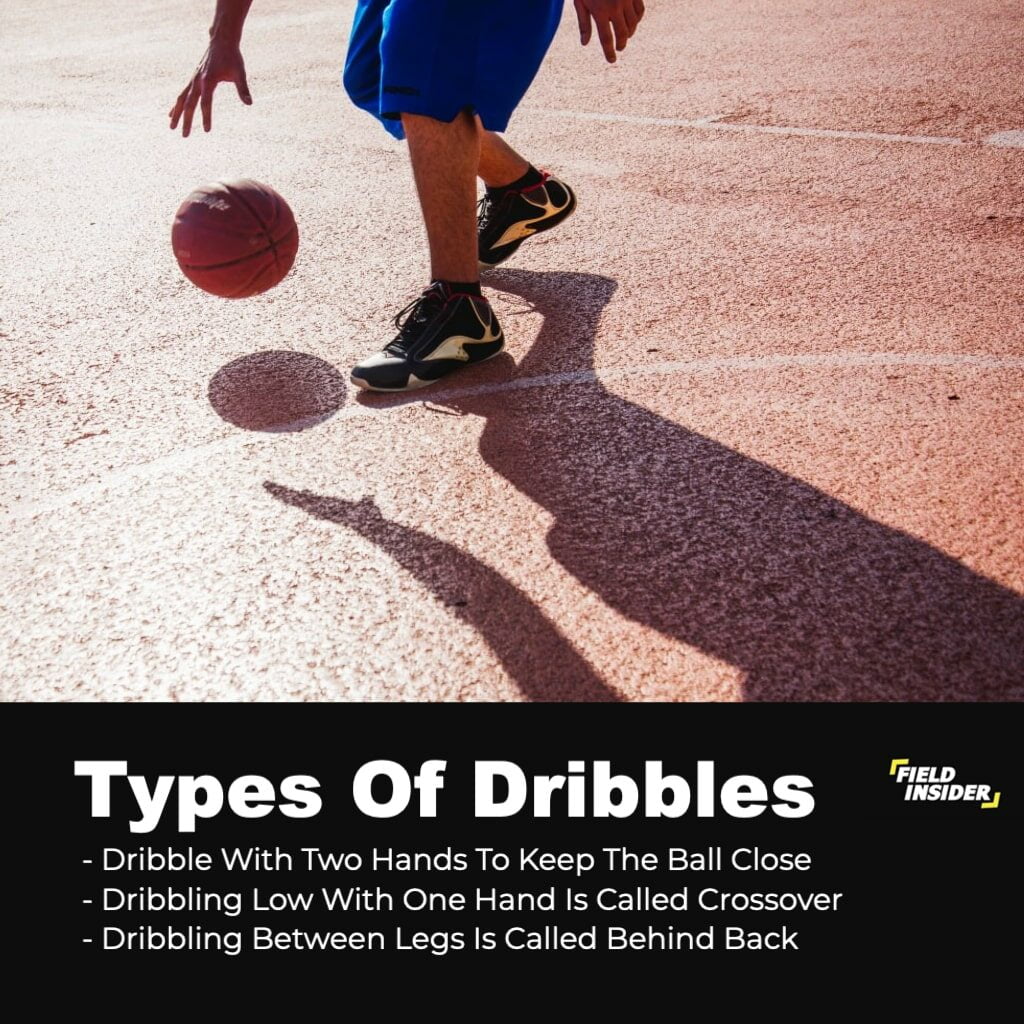
Basketball dribbling moves are an essential part of a player’s arsenal, as they allow players to maneuver past defenders and create scoring opportunities. In this review, we will cover some of the most popular basketball dribbling moves and provide detailed instructions on how to perform them.
- Crossover Dribble: The crossover dribble is one of the most effective moves in basketball. To execute the crossover, the player dribbles the ball with one hand and then quickly crosses it over to the other hand, causing the defender to shift their weight in the wrong direction. To perform a crossover dribble:
Step 1: Start dribbling the ball with your right hand, take a quick step forward with your right foot, and plant it firmly.
Step 2: Use your left hand to quickly cross the ball over to your left side, passing the ball under your right leg.
Step 3: Quickly take a step with your left foot and continue dribbling with your left hand.
- Between the Legs Dribble: The between the legs dribble is a flashy move that can help players create space between themselves and their defenders. To execute the between the legs dribble:
Step 1: Start dribbling the ball with your right hand.
Step 2: Quickly step forward with your right foot and plant it firmly.
Step 3: Use your left hand to dribble the ball between your legs and into your right hand.
Step 4: Quickly step forward with your left foot and continue dribbling with your right hand.
- Behind the Back Dribble: The behind the back dribble is a stylish move that can help players create space and get past defenders. To execute the behind the back dribble:
Step 1: Start dribbling the ball with your right hand.
Step 2: Quickly step forward with your right foot and plant it firmly.
Step 3: Use your left hand to dribble the ball behind your back and into your left hand.
Step 4: Quickly step forward with your left foot and continue dribbling with your left hand.
- Spin Move Dribble: The spin move dribble is a more advanced dribbling technique that requires a lot of practice to master. To execute the spin move dribble:
Step 1: Start dribbling the ball with your right hand.
Step 2: Quickly step forward with your right foot and plant it firmly.
Step 3: Use your left foot to spin your body around, dribbling the ball with your right hand as you turn.
Step 4: Once you’ve completed the spin, continue dribbling with your right hand and take off towards the basket.
- Hesitation Dribble: The hesitation dribble is a great move for creating space and getting past defenders. To execute the hesitation dribble:
Step 1: Start dribbling the ball with your right hand.
Step 2: Take a step forward with your right foot and then pause for a brief moment, as if you are going to stop dribbling.
Step 3: Use a quick burst of speed to drive past your defender and continue dribbling with your right hand.
Overall, basketball dribbling moves are an important part of a player’s game, and mastering them can help players create scoring opportunities and get past defenders. It is important to practice these moves regularly and to master them before using them in games.
How to Dribble a Basketball Under Your Legs
Use this move when you need to dribble past your opponent especially if they are guarding the ball too closely. This is how Allen Iverson used to beat his opponents and how he got so fast!
Instructions:
- Bring basketball up between legs and over the opposite shoulder, then swing it back underneath the other leg and behind out of harm’s way (just like a baseball player would do with their arms).
- As soon as the underarm comes around again, now bring it up high for more power against the defender by pushing off on side of the foot that was previously planted on the ground–this technique gives you maximum height without having to jump or exaggerate steps.
- Now quickly switch hands once you have control of the ball which should be in front of you at this point.
- Lastly, step forward with the opposite leg that was just planted onto the ground so you can gain better speed and direction to get past your opponent! Be sure not to take too big a stride however or it will make you an easy target for stealing again.
Basketball Dribbling Drills
Several types of dribbling drills can be used to improve how well players handle the ball–exercises like dribble-drive motions, figure eights, and multi-directional speed dashes are great ways for developing better skills.
More advanced training methods include crossover pull-ups where you keep your other hand on the side of basketball as it goes up so you don’t lose control!
Also, try doing them underhanded with both hands at once alternating between each one after every successful basket which will help prevent defenders from stealing it off either wrist/elbow area often!
Basketball dribbling drills are an essential part of any basketball player’s training routine. These drills help players improve their ball handling skills, speed, and agility on the court. In this review, we will cover some of the most effective basketball dribbling drills and provide detailed instructions on how to perform them.
Sample Drills and progression:
- Two-Ball Dribbling: Two-ball dribbling is a great drill for improving ball control, hand-eye coordination, and ambidexterity. To perform two-ball dribbling:
Step 1: Start by standing with your feet shoulder-width apart and holding one basketball in each hand.
Step 2: Begin dribbling both balls at the same time, making sure to keep the balls under control and bouncing at the same height.
Step 3: Try to vary the speed and direction of your dribbles, and alternate between dribbling with your right and left hands.
Step 4: As you improve, try to incorporate crossovers and between-the-legs dribbling into the drill.
- Figure 8 Dribbling: The Figure 8 dribbling drill is great for improving ball control, hand-eye coordination, and overall dribbling skills. To perform the Figure 8 dribbling drill:
Step 1: Start by standing with your feet shoulder-width apart and holding a basketball in your right hand.
Step 2: Begin dribbling the ball in front of your body and then move the ball behind your back.
Step 3: As the ball comes around to your left hand, switch hands and begin dribbling with your left hand.
Step 4: Move the ball behind your back again and continue to dribble in a figure 8 pattern between your legs.
Step 5: As you improve, try to speed up the drill and incorporate crossovers and between-the-legs dribbling into the pattern.
- Cone Dribbling: The Cone Dribbling drill is great for improving dribbling speed, agility, and control. To perform the Cone Dribbling drill:
Step 1: Set up four cones in a straight line, spaced about 10 feet apart.
Step 2: Start by dribbling the ball at a moderate pace towards the first cone.
Step 3: As you approach the cone, use a crossover dribble to change direction and move around the cone.
Step 4: Continue dribbling towards the second cone and use a between-the-legs dribble to change direction and move around the cone.
Step 5: Repeat this pattern with the remaining cones, alternating between crossovers and between-the-legs dribbling.
Remember that basketball dribbling drills don’t only have to happen on a court–you can also play games like “Around The World” where players run around cones in order, but if they touch one by accident then they must go back and start over again.
This will improve how well someone responds when under pressure while working on their agility at the same time so it’s double-duty training!
What is the Importance of Dribbling in Basketball?
With how important dribbling is on how players play their game, especially when they need extra space from defenders then going behind the back might give them more room while still being able to keep control over the ball instead of tipping toeing around which would waste time and slow things down.
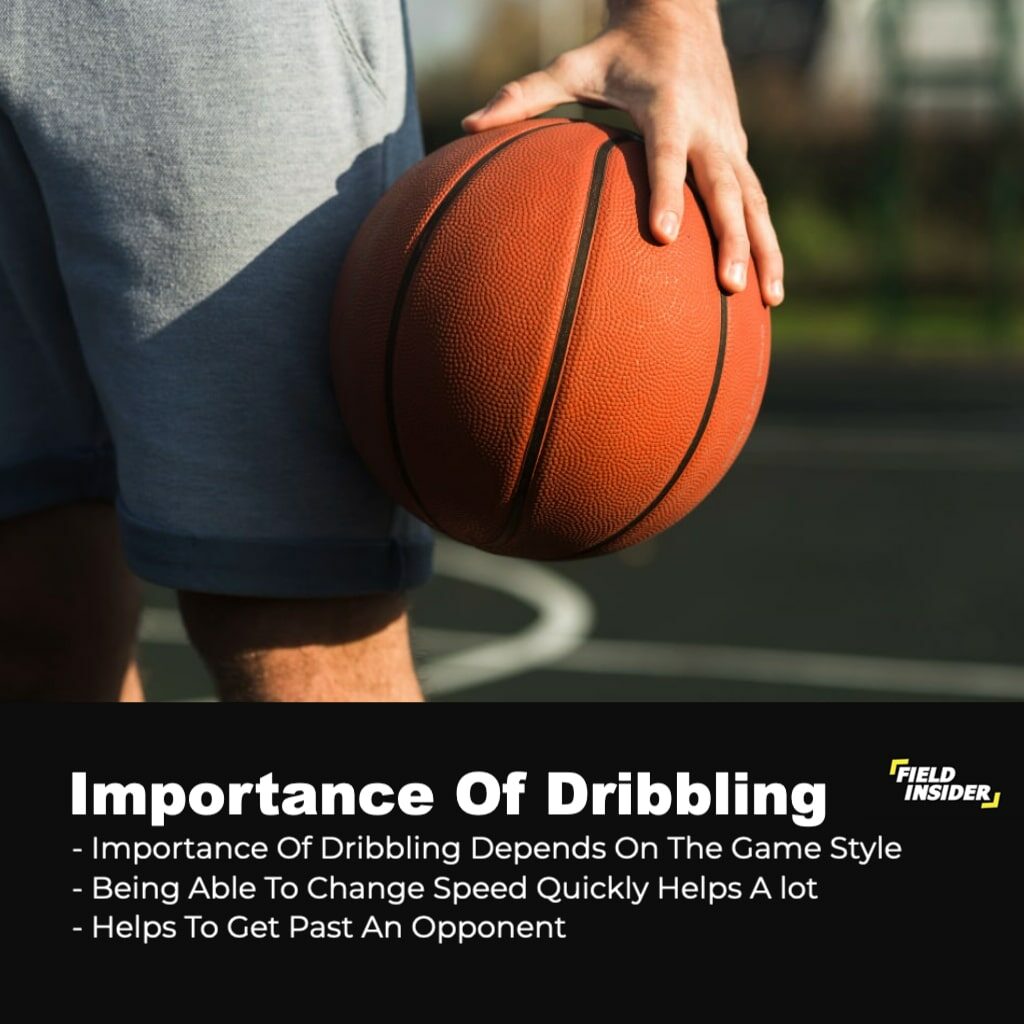
Basketball players need good dribbling abilities to succeed because they can handle the ball while moving up the court and setting up scoring possibilities. Basketball’s most fundamental ball handling technique is dribbling, which also serves as the basis for other techniques like passing, shooting, and driving to the basket. In this review, we’ll examine the value of proficient dribbling in basketball and how it affects a player’s overall output.
- Control and Agility: Players with good dribbling techniques can move around the court, change directions, and evade defenders while still maintaining possession of the ball. Players that dribble with control and agility may move quickly and precisely, maneuver through traffic, and open up scoring chances. While they can keep the ball away from defenders and make wise decisions, players with high dribbling ability are also less prone to create turnovers.
- Penetration: Dribbling is a crucial technique for athletes who want to drive to the basket and score points, according to penetration. Using different dribble maneuvers like crossovers and between-the-legs dribbling, a player with good dribbling ability can open up space and get past defenders. Players can change their speed and direction when dribbling, which can throw off defenders and open up scoring possibilities.
- Passing: Dribbling proficiency is also necessary for passing. Effective dribblers can move the ball around the floor fast and effectively, making it simpler to find open teammates and create scoring opportunities. By maneuvering the ball around defenders and creating space for their teammates, players can also generate passing angles while dribbling.
- Transition: Dribbling is essential for teams who prefer to play transition games at a rapid tempo. Effective dribblers can advance the ball up the court rapidly and set up fast break opportunities. Players with good dribbling abilities can also keep control of the ball during frantic action, which facilitates quick decisions and the creation of scoring possibilities.
Conclusion
We have covered how to dribble a basketball, how to improve how well someone can do it, and some drills that one can use. We have also mentioned how important dribbling is in the game of basketball as an offensive move that helps players get past their defender or build up speed/momentum when needed.
We hope that this blog post has helped you learn how to dribble a basketball. If you have any further questions or comments then feel free to leave them below.




